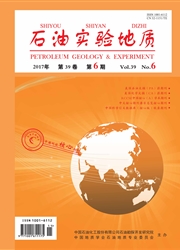

 中文摘要:
中文摘要:
:基于地震地质解释,刻画了塔里木盆地中北部断裂体系的平、剖面特征,分析了不同断裂体系的结构模式、形成机制及演化历史.结果表明,该区分为4个断裂体系:(1)托普台“X”型走滑断裂体系,下古生界主要发育NNE、NNW向“X”型共轭剪切破裂及“1”字形直立构造、正花状构造,而中新生界多表现为NNE向雁列式张性正断裂及负花状、堑垒构造;(2)塔中NW向逆冲断裂体系,以近NW向基底卷入式或滑脱式逆冲断裂为主,发育“y”字形构造;(3)顺托NE向走滑断裂体系,奥陶系及以下层系表现为近NE向左旋走滑及“1”字形直立、正花状构造,而志留-泥盆系主要发育近NE向雁列式张性正断裂及负花状、堑垒构造;(4)塔河盐下“T”型断裂体系,下古生界层系由近EW向逆冲断裂与近SN、NNE向走滑断裂组成,中新生界层系主要发育NEE向、近SN向雁列式张性正断裂组.断裂体系的研究明确了研究区压扭走滑和张扭走滑作用的叠加改造过程,认为主要受控于盆缘古洋盆5期的消减闭合及碰撞造山作用.结合研究区构造动力学背景分析,将该区断裂体系的演化过程划分为中晚奥陶世的强挤压弱走滑期、晚志留-中泥盆世的强挤压强走滑期、晚石炭-早中二叠世的强拉张弱走滑期、晚二叠世-三叠纪的强挤压弱走滑期和侏罗纪-新近纪的弱挤压弱走滑期.
 英文摘要:
英文摘要:
This paper described the horizontal and vertical characteristics of fault systems in the central and northern Tarim Basin, and analyzed the structural model, formation mechanism and evolution history of the fault systems based on extensive 2D/3D seismic data. Four series of fault systems were preliminarily classified. (1) The "X"-type strike-slip fault system (Ⅰ1) in the Tuoputai area is composed of nearly NNE, NNW trending "X"-style conjugate shear fractures and "1"-style vertical structures and positive flower structures in the Lower Paleozoic strata, and are composed of NNE trending en-echelon extension fractures and negative flower structures and graben-horst structures in the Mesozoic and Cenozoic strata. (2) The NW trending thrust fault system (Ⅰ2) in the central Tarim area is composed of nearly NW trending basement-involved and cover-slipping thrust faults and "Y"-style structures. (3) The NE trending strike-slip fault system (Ⅰ3) in the Shuntuo area is composed of nearly NE trending left-lateral strike-slip faults and "1"-style vertical structures and positive flower structures in the Ordovician and lower strata, and is composed of ENE trending en-echelon extensional fractures and negative flower structures and graben-horst structures in the Silurian-Devonian strata. (4) The "T"-type fault system (Ⅰ4) in the Tahe subsalt area is composed of nearly EW trending thrust faults and nearly NS, NNE trending strike-slip faults in the Lower Paleozoic strata, and is composed of NNE,nearly SN trending en-echelon extensional fractures in the Mesozoic and Cenozoic strata. The study of fault system illustrated the superimposition and transformation between extensional strike-slip and transtensional strike-slip, and considered that it was mainly controlled by five stages of subduction and collision orogeny in the paleo oceanic basin on the basin margin. Combined with the dynamic evolution mechanism of the study area, the evolution stage of the central and n
 同期刊论文项目
同期刊论文项目
 同项目期刊论文
同项目期刊论文
 期刊信息
期刊信息
